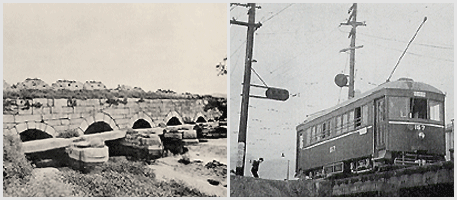|
|
 Ogansumun (Five-bay Water Gate) Ogansumun (Five-bay Water Gate)
|
|
|
The waterway of Cheonggyecheon in the Joseon period crossed the central part of the capital and ran eastward to meet the
stream of Jungnyangcheon before flowing into the Hanang (River). Ogansumun, literally “Five-bay Water Gate,” is a structure
built under the fortress wall at the south of Heunginjimun, or Dongdatmun (Great East Gate), designed to help the
Cheonggyecheon water flow freely through the wall into the Hangang. There had been another water gate named Igansumun
(“Double-bay Water Gate”) designed to control the water flowing from Namsomun-dong, a district at the mountain skirt of
Namsan.
There are not records indicating when Ogansumun was first built although most historians agree that it
was made when the fortress of Hanyang (today’s Seoul) was constructed as the capital of the newly established Joseon dynasty.
Each bay of Ogansumun bridge had grating to block people from passing through while admitting free flow of water.
Despite the steel bars, however, the water gates continued to be a secret passage for those who wanted to get in and out of
the capital without the permission of the authorities. This is clearly shown in the story of Im Kkeok-jeong, the “righteous
bandit leader” in the days when Joseon was under the rule of King Myeongjong, who safely fled the capital through the water
passage of Ogansumun. Gradually, however, the iron-barred passages were blocked by drift heaped up by water currents and were
inoperative. The iron bars were temporarily replaced by wooden gates, but they soon became useless too, requiring the
authorities to adopt a more fundamental solution.
A major project to secure water passages by dredging took
place in 1760 when the Joseon dynasty was under the rule of King Yeongjo. Iron bars were installed again, this time along with
willow trees that are known to help keep drifts from blocking the gates. With this work, Ogansumun was now able to play its
intended role. History shows that the success of the dredging project was greatly indebted by King Yeongjo, who made several
official visits to the dredging site to encourage workers. One of the royal visits was captured by a court painter in a
painting produced in 1760 under the title, Juncheondo (“A Scene of Dredging Work”). The painting shows, in addition to King
Yeongjo with his retainers, an entire view of Ogansumun with five iron-barred water gates and dense willow trees growing
around the waterway. The site with the renovated water gates and leafy willow trees made this one of the capital’s most
favored venues for springtime outings.
The tragic end of Ogansumun started in 1907 when a minister named Yu
Maeng of the Central Advisory Council (Jungchuwon) decided to remove iron bars in an effort to secure a freer passage of
water. The final blow came the following year when the authorities demolished the water gates along with fortress walls on
both sides of Dongdaemun (“Great Eastern Gate”), and built a “modern” concrete bridge crossing the waterway.
The water gate is now often referred to as Ogansugyo or Ogansudari, both meaning a bridge. Neither name is correct, however,
because it was originally built as a water gate not as a bridge although guards of the fortress walls and officials
responsible for the management of the water gate used it to cross the waterway. The official name for the structure was always
Ogansumun for the Joseon’s 500-year history.
|
|

|
It was after the modern bridge was constructed over the site by Japanese imperialists that the original name of
Ogansumun began to be replaced by Ogansugyo. In June of 1921, the Japanese imperialists built an iron bridge over the water
gate as part of a project to build a tramline linking Dongdaemun with Gwanghuimun. When the tramline was completed and a
car house was built at the site where Dongdaemun Market is today, Ogansugyo suddenly became the busiest part of the
tramline. Ogansugyo underwent yet another extension in June, 1926, when it was part of the route for the funeral procession
of Emperor Sunjong, the last monarch of the Korean Empire, that proceeded to the royal tomb of Yureung in today’s
Geumgok-dong, Namyangju-si of Gyeonggi-do. They enlarged the width of the bridge from 4.5 to 8.2 meters for the safe
passage of the procession.
|
| |
|
|
|
|
|
|






